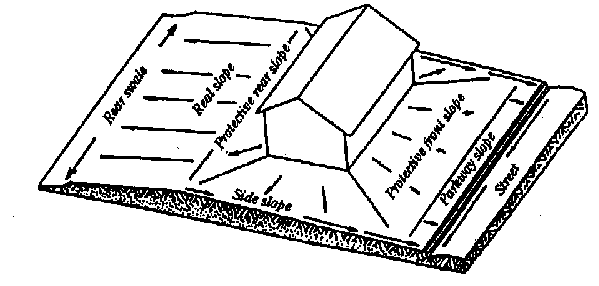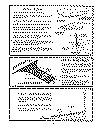SMALL SITE EROSION AND SEDIMENT CONTROL
GUIDANCE
Indiana
Department of Natural Resources
(317) 232-4020
This
document is downloadable in WordPerfect format. Click
on the graphics to view full size.
Soil erosion and resulting sedimentation are
a leading cause of water quality problems in Indiana. Although erosion has long been
associated with farming activities, it is also a major concern at construction sites, if
the disturbed land is left unprotected. Every phase of a construction project has the
potential of contributing significant quantities of sediment-laden runoff. Therefore, as a
site is developed, all who are associated with the project must do their part to control
erosion.
This pamphlet deals with erosion/sediment
control on an individual building lot. First it looks at some consequences of construction
site erosion and presents four principles important for control. Next it addresses the
issue of proper lot drainage. Then it presents the seven steps within a construction
sequence that should result in effective erosion control. Also included are installation
instructions for five commonly used building site control practices as well as suggested
references materials and sources of further assistance.
PRIMARY CONCERNS RELATED TO
EROSION AND SEDIMENTATION
Water quality. Sediment is the number
one pollutant, by volume, of surface water in the state of Indiana. It impacts water
quality by degrading the habitat of aquatic organisms and fish, by decreasing recreational
value, and by promoting the growth of nuisance weeds and algae.
Local taxes. Sediment that finds its
way into streets, storm sewers, and ditches results in additional maintenance costs for
local government.
Flooding. Sediment accumulation in
streams, lakes, and rivers reduces their capacity, which can result in increased flooding.
Property values. Sediment deposits not
only impair water quality but also damage property, thus reducing its use and value.
PRINCIPLES FOR CONTROLLING
BUILDING SITE EROSION AND SEDIMENTATION
Erosion control is important on any building
site regardless of its size. Usually, the principles and methods for controlling erosion
and reducing off-site sedimentation are relatively simple and inexpensive. Here are four
basics to be followed when developing a building site.
Evaluate the site. Inventory and
evaluate the resources on the lot before building. Location of structures should be based,
in large part, on the lot=s natural features. Identify trees that you want to save and
vegetation that will remain during construction. Also identify areas where you want to
limit construction traffic. Wherever possible, preserve existing vegetation to help
control erosion and off-site sedimentation.
Select and install erosion/sediment
control practices. Determine the specific ones needed, and install them before
clearing the site. Among the more commonly used practices are vegetative filter strips,
silt fence, gravel drives, and runoff inlet protection.
Develop a practice maintenance program. Maintenance
of all practices is essential for them to function properly. They should be inspected
twice a week and after each rainfall event. When a problem is identified, repair the
practice immediately. Also, any sediment that is tracked onto the street should be scraped
and deposited in a stable area. Do not flush sediment from the street with water.
Revegetate the site. Do so as soon
as possible. A well-maintained lot has a higher sale potential.
BUILDING LOT DRAINAGE
The best time to provide for adequate lot
drainage is before construction begins. With proper planning, most drainage problems can
be avoided. And that's important because correcting a problem after it occurs is usually
much more difficult and costly. Here's what it takes to ensure good lot surface and
subsurface drainage.
Surface Drainage
Position the structure a minimum of 18 inches
above street level.
Divert stormwater runoff away from the
structure by grading the lawn to provide at least 6 inches of vertical fall in the first
10 feet of horizontal distance.

Construct side and rear yard swales to take
surface water away from the structure.

Avoid filling in existing drainage channels
and roadside ditches, since that could result in wetness problems on someone else's
property and/or damage to adjacent road surfaces.
Subsurface Drainage
Provide an outlet for foundation or footer
drains and for general lot drainage by using storm sewers (where allowed), OR obtain
drainage easements if you must cross adjoining properties.
If you accidently cut through an existing
field tile, assume that it carries water even if currently dry; therefore, re-route it
(using the same size tile) around the structure or septic field; then reconnect it.
STEP 1. EVALUATE THE SITE.
Before construction, evaluate the entire
site, marking for protection any important trees and associated rooting zones, unique
areas to be preserved, on-site septic system absorption fields, and vegetation suitable
for filter strips, especially in perimeter areas.
Identify Vegetation To Be Saved.
Select and identify the trees, shrubs, and
other vegetation that you want to save (see "Vegetative Filter Strips" under
Step 2 below).
Protect Trees and Sensitive Areas.
To prevent root damage, do no grade, burn,
place soil piles, or park vehicles near trees or in areas marked for preservation.
Place plastic mesh or snow fence barriers
around the tree's dripline to protect the area below their branches.
Place a physical barrier, such as plastic
fencing, around the area designated for a septic system absorption field (if applicable).
STEP 2. INSTALL PERIMETER EROSION
AND SEDIMENT CONTROLS.
Identify the areas where sediment-laden
runoff could leave the construction site, and install perimeter controls to minimize the
potential for off-site sedimentation. It's important that perimeter controls are in place
before any other earth-moving activities begin.
Protect Down-Slope Areas.
With Vegetative Filter Strips
On slopes of less than 6 percent,
preserve a 20- to 30-foot wide vegetative buffer strip around the perimeter of the
property, and use it as a filter strip for trapping sediment Do not mow filter strip
vegetation shorter than 4 inches.
With Silt Fence
Use silt fencing along the perimeter
of the lot's downslope side(s) to trap sediment (see Exhibit #3)
Install Gravel Drive.
Restrict all lot access to this drive to
prevent vehicles from tracking mud onto roadways (see Exhibit #4).
Protect Storm Sewer Inlets.
Protect nearby storm sewer curb inlets with
stone-filled or gravel-filled geotextile bags (see Exhibit #1) or equivalent
measures before disturbing soil.
Protect on-site storm sewer drop inlets with
silt fence material (see Exhibit #2), straw bales, or equivalent measures before
disturbing soil.
Construction Sequence for
Building Site Erosion Control Practices
 Sample Erosion/Sediment Control Practice Plan for a Typical One or Two
Family Dwelling Under Construction
Sample Erosion/Sediment Control Practice Plan for a Typical One or Two
Family Dwelling Under Construction
STEP 3. PREPARE THE SITE FOR
CONSTRUCTION.
Prepare the site for construction and for
installation of utilities. Make sure all contractors (especially the excavating
contractor) are aware of areas to be protected.
Salvage and Stockpile the Topsoil/subsoil.
Remove topsoil (typically the upper 4 to 6
inches of soil material) and stockpile.
Remove subsoil and stockpile separately from
the topsoil.
Locate the stockpiles away from any downslope
street, driveway, stream, lake, wetland, ditch, or drainageway.
Immediately after stockpiling, temporary-seed
the stockpiles with annual rye or winter wheat and/or place sediment barriers around the
perimeter of the piles.
STEP 4. BUILD THE STRUCTURE(S)
AND INSTALL THE UTILITIES.
Construct the home and install the utilities;
also install the sewage disposal system and drill the water well (if applicable); then
consider the following.
Install Downspout Extenders.
Although not required, downspout extenders
are highly recommended as a means of preventing lot erosion from roof runoff.
Add the extenders as soon as the gutters and
downspouts are installed (see Exhibit #5).
Be sure the extenders have a stable
outlet, such as the street, sidewalk, or a well vegetated area.
STEP 5. MAINTAIN THE CONTROL
PRACTICES.
Maintain all erosion and sediment control
practices until construction is completed and the lot is stabilized.
Inspect the control practices a minimum of
twice a week and after each storm event, making any needed repairs immediately.
Toward the end of each work day, sweep or
scrape up any soil tracked onto roadways. Do not flush area with water.
By the end of the next work day after a storm
event, clean up any soil washed off-site.
STEP 6. REVEGETATE THE BUILDING
SITE.
Immediately after all outside construction
activities are completed, stabilize the lot with sod, seed, and/or mulch.
Redistribute the Stockpiled Subsoil and
Topsoil.
Spread the stockpiled subsoil to rough grade.
Spread the stockpiled topsoil to a depth of 4
to 6 inches over rough-graded areas.
Fertilize and lime according to soil test
results or recommendations of a seed supplier or a professional landscaping contractor.
Mulch Newly Seeded Areas.
Spread straw mulch on newly seeded areas,
using 12 to 2 bales of straw per 1,000 square feet.
On flat or gently sloping land, anchor the
mulch by crimping it 2 to 4 inches into the soil. On steep slopes, anchor the mulch with
netting or tackifiers. An alternative to anchored mulch would be the use of erosion
control blankets.
STEP 7. REMOVE REMAINING
TEMPORARY CONTROL MEASURES.
Once the sod and/or vegetation is well
established, remove any remaining temporary erosion and sediment control practices, such
as:
Downspout extenders. (Or shorten to outlet
onto the vegetated areas, allowing for maximum infiltration).
Storm sewer inlet protection measures.
REFERENCE MATERIALS
Every building site is unique and poses its
own restraints and potential erosion hazards. In many instances, additional or alternative
methods are necessary if your let is:
Adjacent to a creek, lake, or wetland.
Has slopes in excess of 6 percent.
Receives runoff from adjacent areas.
Has more than one acre of disturbed ground.
This pamphlet provides installation
instruction on five of the more commonly used building site erosion and sediment control
practices. For information on other related practices, see the Indiana Handbook for
Erosion Control in Developing Areas, available from the Division of Soil Conservation,
Indiana Department of Natural Resources, 402 West Washington Street, Indianapolis, IN
46204-2748. For an order form, call the Division office at 317-233-3870.
Another valuable reference when building a
home is your county=s detailed soil survey report, which contains information about soil
hazards and limitations (such as wetness) that may need to be addressed at the time of
construction. Single copies of the soil survey are available at your local Soil and Water
Conservation District (SWCD) office.
SWCDs also provide free technical assistance
regarding the management of soil and water resources.
LOCAL EROSION CONTROL ORDINANCES
It is the responsibility of property owners
and contractors to see that they are in compliance with state laws and local and county
ordinances regarding construction site erosion and sediment control.
 Five Common Erosion/Sediment Control Practices
Five Common Erosion/Sediment Control Practices
 Drop Inlet Protection
Drop Inlet Protection
 Silt
Fence, Gravel Entrance, Downspout Extenders
Silt
Fence, Gravel Entrance, Downspout Extenders





